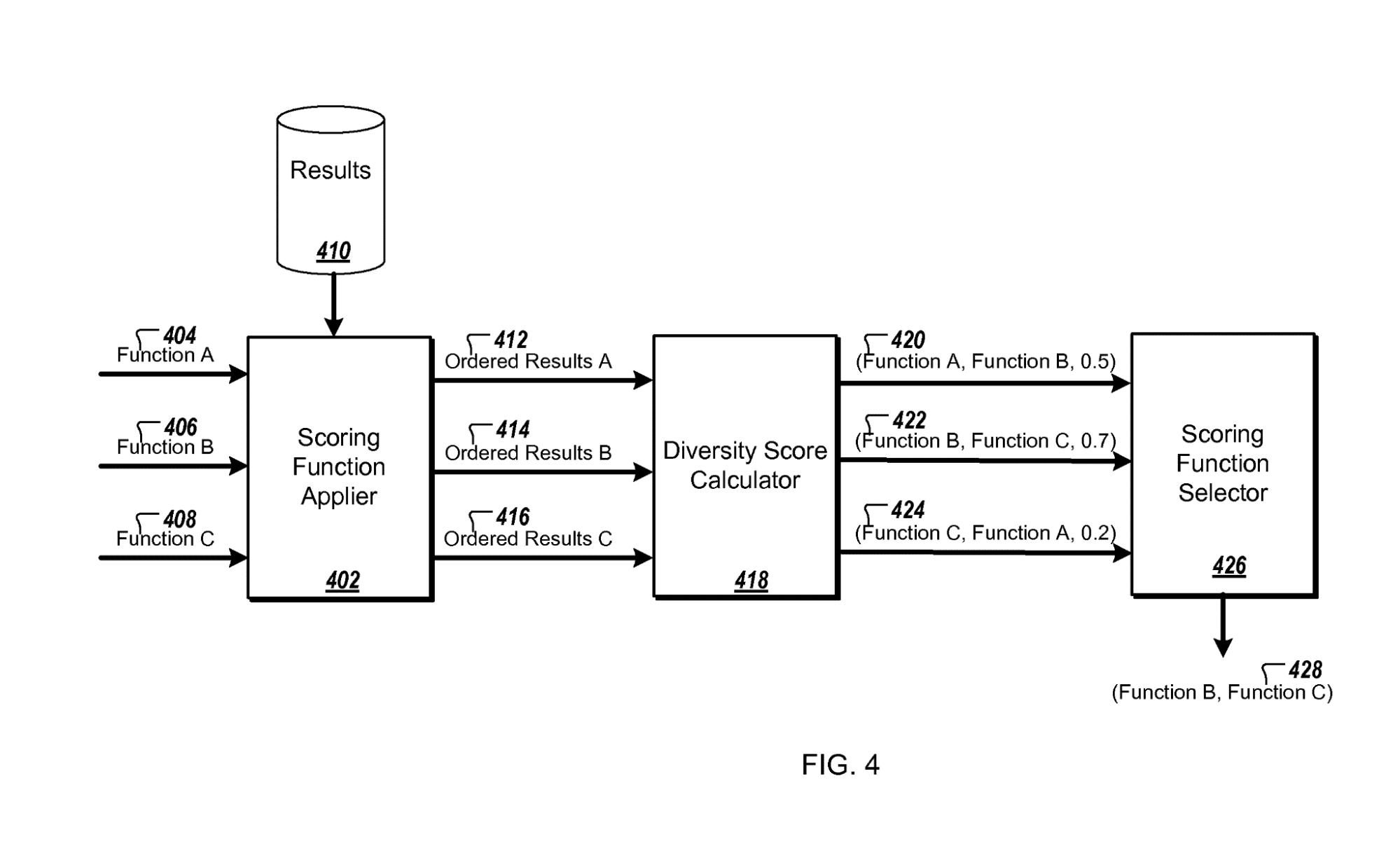Friday, May 31, 2024
3 Dead As Fire Breaks Out At Paint Factory In Tamil Nadu's Thiruvallur
Google to honor new privacy laws and user opt-outs

Google is rolling out changes to comply with new state privacy laws and user opt-out preferences across its ads and analytics products in 2024.
The big picture. Google is adjusting its practices as Florida, Texas, Oregon, Montana and Colorado enact new data privacy regulations this year.
Key updates include:
Restricted Data Processing (RDP) (which is when Google limits how it uses data to only show non-personalized ads) for new state laws:
- Google will update its ads terms to enable RDP for these states as their laws take effect.
- This allows Google to act as a data processor rather than a controller for partner data while RDP is enabled.
- No additional action required if you’ve already accepted Google’s online data protection terms.
Honoring global privacy control opt-outs:
- To comply with Colorado’s Universal Opt-Out Mechanism, Google will respect Global Privacy Control signals sent directly from users.
- This will disable personalized ad targeting based on things like Customer Match and remarketing lists for opted-out users.
Why we care. This change Google is implementing will help keep advertisers on the right side of the law when it comes to privacy. However, the changes could impact ad targeting efficiency and personalization capabilities as more users opt out.
What they’re saying. Here’s what Google told partners in an email:
- “If you’ve already agreed to the online data protection terms, customers [i.e. advertisers] should note that Google can receive Global Privacy Control signals directly from users and will engage RDP mode on their behalf.”
Bottom line. Google is taking steps to help partners comply with tightening data privacy rules, even if it means limiting its own ad targeting.
from Search Engine Land https://ift.tt/GNwlaEc
via https://ift.tt/bZ7S85L https://ift.tt/GNwlaEc
In Pune Porsche Crash Case, Cops Seek Teen's Father's Custody
Thursday, May 30, 2024
Assam Police Seize 2,100 Illegal Cough Syrup Bottles, 3 Arrested
How SEO moves forward with the Google Content Warehouse API leak

In case you missed it, 2,569 internal documents related to internal services at Google leaked.
A search marketer named Erfan Amizi brought them to Rand Fishkin’s attention, and we analyzed them.
Pandemonium ensued.
As you might imagine, it’s been a crazy 48 hours for us all and I have completely failed at being on vacation.
Naturally, some portion of the SEO community has quickly fallen into the standard fear, uncertainty and doubt spiral.
Reconciling new information can be difficult and our cognitive biases can stand in the way.
It’s valuable to discuss this further and offer clarification so we can use what we’ve learned more productively.
After all, these documents are the clearest look at how Google actually considers features of pages that we have had to date.
In this article, I want to attempt to be more explicitly clear, answer common questions, critiques, and concerns and highlight additional actionable findings.
Finally, I want to give you a glimpse into how we will be using this information to do cutting-edge work for our clients. The hope is that we can collectively come up with the best ways to update our best practices based on what we’ve learned.
Reactions to the leak: My thoughts on common criticisms
Let’s start by addressing what people have been saying in response to our findings. I’m not a subtweeter, so this is to all of y’all and I say this with love. 
‘We already knew all that’
No, in large part, you did not.
Generally speaking, the SEO community has operated based on a series of best practices derived from research-minded people from the late 1990s and early 2000s.
For instance, we’ve held the page title in such high regard for so long because early search engines were not full-text and only indexed the page titles.
These practices have been reluctantly updated based on information from Google, SEO software companies, and insights from the community. There were numerous gaps that you filled with your own speculation and anecdotal evidence from your experiences.
If you’re more advanced, you capitalized on temporary edge cases and exploits, but you never knew exactly the depth of what Google considers when it computes its rankings.
You also did not know most of its named systems, so you would not have been able to interpret much of what you see in these documents. So, you searched these documents for the things that you do understand and you concluded that you know everything here.
That is the very definition of confirmation bias.
In reality, there are many features in these documents that none of us knew.
Just like the 2006 AOL search data leak and the Yandex leak, there will be value captured from these documents for years to come. Most importantly, you also just got actual confirmation that Google uses features that you might have suspected. There is value in that if only to act as proof when you are trying to get something implemented with your clients.
Finally, we now have a better sense of internal terminology. One way Google spokespeople evade explanation is through language ambiguity. We are now better armed to ask the right questions and stop living on the abstraction layer.
‘We should just focus on customers and not the leak’
Sure. As an early and continued proponent of market segmentation in SEO, I obviously think we should be focusing on our customers.
Yet we can’t deny that we live in a reality where most of the web has conformed to Google to drive traffic.
We operate in a channel that is considered a black box. Our customers ask us questions that we often respond to with “it depends.”
I’m of the mindset that there is value in having an atomic understanding of what we’re working with so we can explain what it depends on. That helps with building trust and getting buy-in to execute on the work that we do.
Mastering our channel is in service of our focus on our customers.
‘The leak isn’t real’
Skepticism in SEO is healthy. Ultimately, you can decide to believe whatever you want, but here’s the reality of the situation:
- Erfan had his Xoogler source authenticate the documentation.
- Rand worked through his own authentication process.
- I also authenticated the documentation separately through my own network and backchannel resources.
I can say with absolute confidence that the leak is real and has been definitively verified in several ways including through insights from people with deeper access to Google’s systems.
In addition to my own sources, Xoogler Fili Wiese offered his insight on X. Note that I’ve included his call out even though he vaguely sprinkled some doubt on my interpretations without offering any other information. But that’s a Xoogler for you, amiright? 
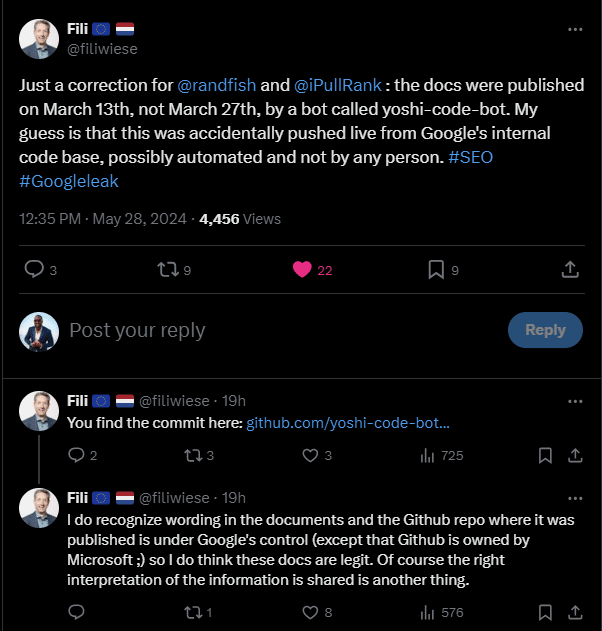
Finally, the documentation references specific internal ranking systems that only Googlers know about. I touched on some of those systems and cross-referenced their functions with detail from a Google engineer’s resume.
Oh, and Google just verified it in a statement as I was putting my final edits on this.
“This is a Nothingburger”
No doubt.
I’ll see you on page 2 of the SERPs while I’m having mine medium with cheese, mayo, ketchup and mustard.
“It doesn’t say CTR so it’s not being used”
So, let me get this straight, you think a marvel of modern technology that computes an array of data points across thousands of computers to generate and display results from tens of billions of pages in a quarter of a second that stores both clicks and impressions as features is incapable of performing basic division on the fly?
… OK.
“Be careful with drawing conclusions from this information”
I agree with this. We all have the potential to be wrong in our interpretation here due to the caveats that I highlighted.
To that end, we should take measured approaches in developing and testing hypotheses based on this data.
The conclusions I’ve drawn are based on my research into Google and precedents in Information Retrieval, but like I said it is entirely possible that my conclusions are not absolutely correct.
“The leak is to stop us from talking about AI Overviews”
No.
The misconfigured documentation deployment happened in March. There’s some evidence that this has been happening in other languages (sans comments) for two years.
The documents were discovered in May. Had someone discovered it sooner, it would have been shared sooner.
The timing of AI Overviews has nothing to do with it. Cut it out.
“We don’t know how old it is”
This is immaterial. Based on dates in the files, we know it’s at least newer than August 2023.
We know that commits to the repository happen regularly, presumably as a function of code being updated. We know that much of the docs have not changed in subsequent deployments.
We also know that when this code was deployed, it featured exactly the 2,596 files we have been reviewing and many of those files were not previously in the repository. Unless whoever/whatever did the git push did so with out of date code, this was the latest version at the time.
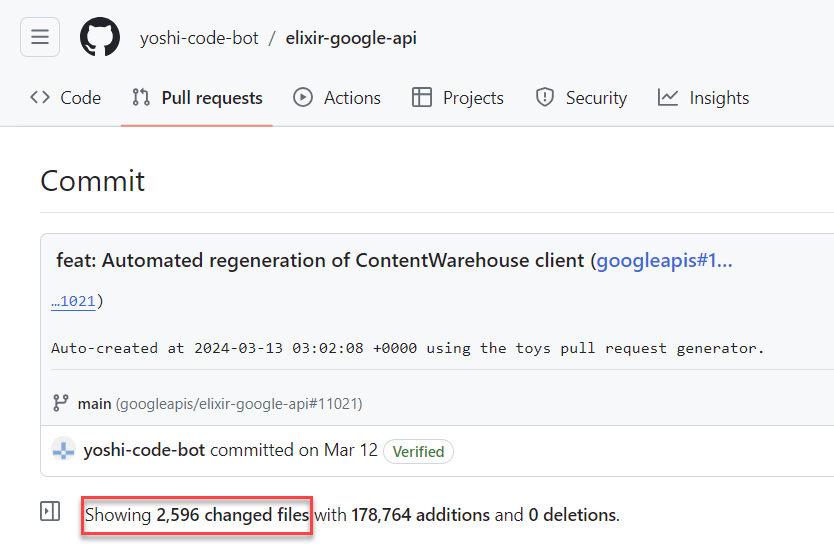
The documentation has other markers of recency, like references to LLMs and generative features, which suggests that it is at least from the past year.
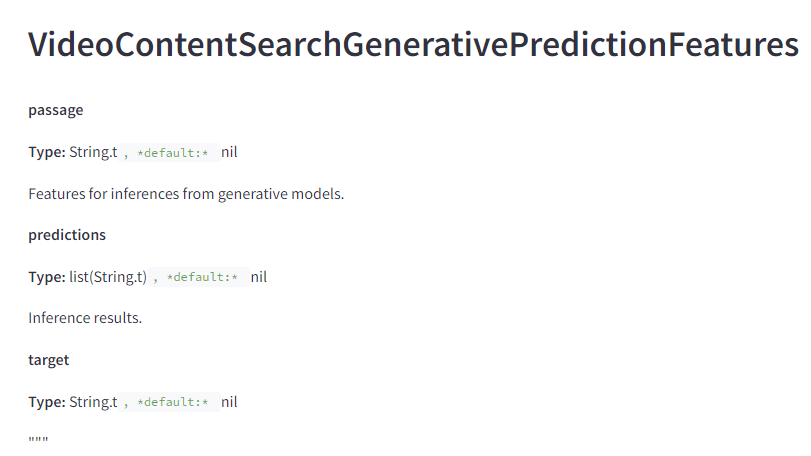
Either way it has more detail than we have ever gotten before and more than fresh enough for our consideration.
“This all isn’t related to search”
That is correct. I indicated as much in my previous article.
What I did not do was segment the modules into their respective service. I took the time to do that now.
Here’s a quick and dirty classification of the features broadly classified by service based on ModuleName:
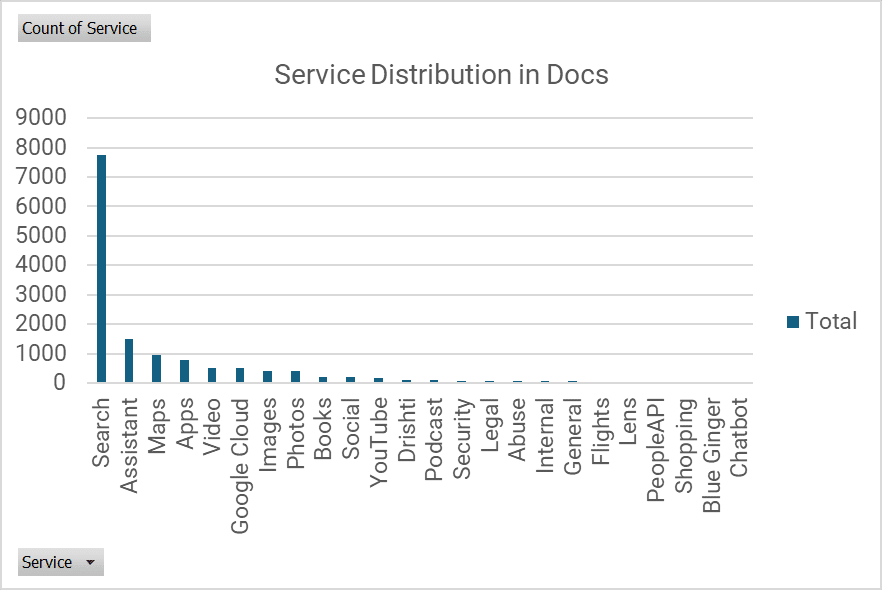
Of the 14,000 features, roughly 8,000 are related to Search.
“It’s just a list of variables”
Sure.
It’s a list of variables with descriptions that gives you a sense of the level of granularity Google uses to understand and process the web.
If you care about ranking factors this documentation is Christmas, Hanukkah, Kwanzaa and Festivus.
“It’s a conspiracy! You buried [thing I’m interested in]”
Why would I bury something and then encourage people to go look at the documents themselves and write about their own findings?
Make it make sense.
“This won’t change anything about how I do SEO”
This is a choice and, perhaps, a function of me purposely not being prescriptive with how I presented the findings.
What we’ve learned should at least enhance your approach to SEO strategically in a few meaningful ways and can definitely change it tactically. I’ll discuss that below.
FAQs about the leaked docs
I’ve been asked a lot of questions in the past 48 hours so I think it’s valuable to memorialize the answers here.
What were the most interesting things you found?
It’s all very interesting to me, but here’s a finding that I did not include in the original article:
Google can specify a limit of results per content type.
In other words, they can specify only X number of blog posts or Y number of news articles can appear for a given SERP.
Having a sense of these diversity limits could help us decide which content formats to create when we are selecting keywords to target.
For instance, if we know that the limit is three for blog posts and we don’t think we can outrank any of them, then maybe a video is a more viable format for that keyword.
What should we take away from this leak?
Search has many layers of complexity. Even though we have a broader view into things we don’t know which elements of the ranking systems trigger or why.
We now have more clarity on the signals and their nuances.
What are the implications for local search?
Andrew Shotland is the authority on that. He and his group at LocalSEOGuide have begun to dig into things from that perspective.
What are the implications for YouTube Search?
I have not dug into that, but there are 23 modules with YouTube prefixes.
Someone should definitely do and interpretation of it.
How does this impact the (_______) space?
The simple answer is, it’s hard to know.
An idea that I want to continue to drill home is that Google’s scoring functions behave differently depending on your query and context. Given the evidence we see in how the SERPs function, there are different ranking systems that activate for different verticals.
To illustrate this point, the Framework for evaluating web search scoring functions patent shows that Google has the capability to run multiple scoring functions simultaneously and decide which result set to use once the data is returned.
While we have many of the features that Google is storing, we do not have enough information about the downstream processes to know exactly what will happen for any given space.
That said, there are some indicators of how Google accounts for some spaces like Travel.
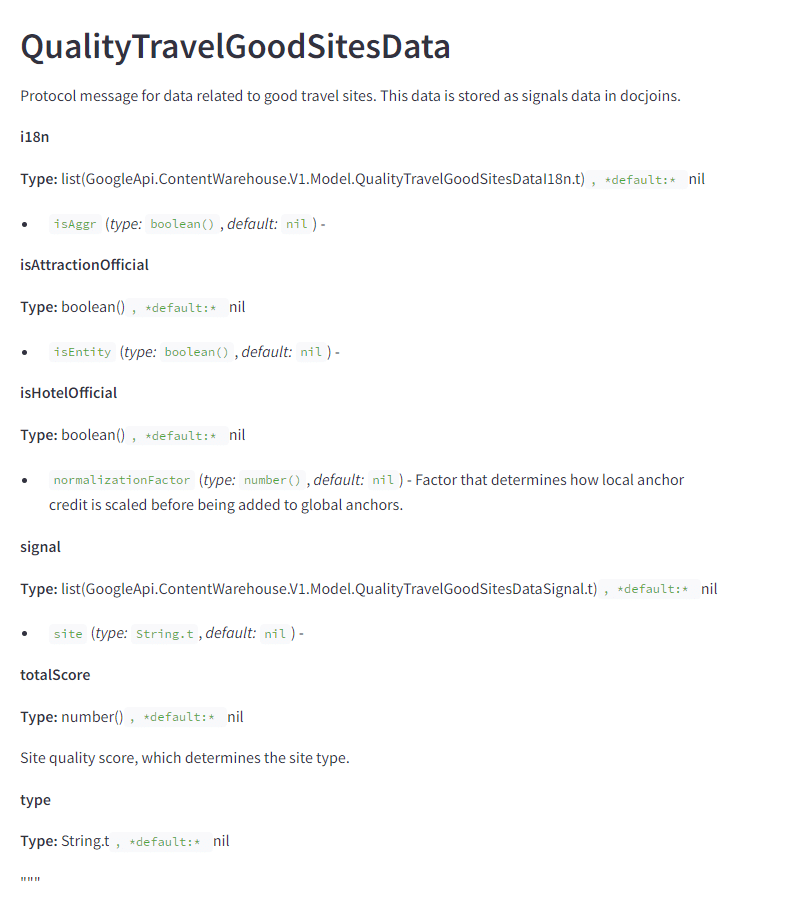
The QualityTravelGoodSitesData module has features that identify and score travel sites, presumably to give them a Boost over non-official sites.
Do you really think Google is purposely torching small sites?
I don’t know.
I also don’t know exactly how smallPersonalSite is defined or used, but I do know that there is a lot of evidence of small sites losing most of their traffic and Google is sending less traffic to the long tail of the web.
That’s impacting the livelihood of small businesses. And their outcry seems to have fallen on deaf ears.
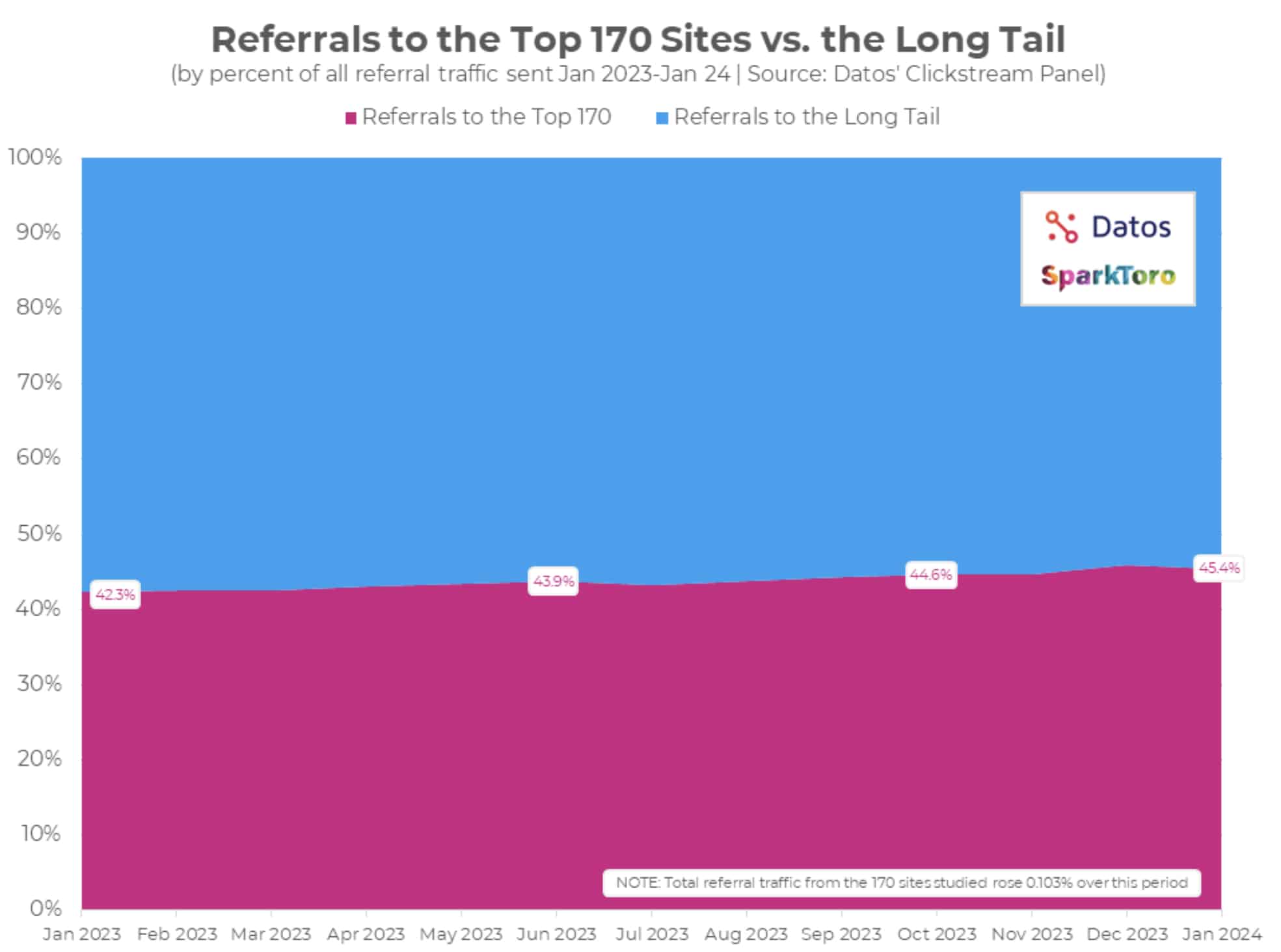
Signals like links and clicks inherently support big brands. Those sites naturally attract more links and users are more compelled to click on brands they recognize.
Big brands can also afford agencies like mine and more sophisticated tooling for content engineering so they demonstrate better relevance signals.
It’s a self-fulfilling prophecy and it becomes increasingly difficult for small sites to compete in organic search.
If the sites in question would be considered “small personal sites” then Google should give them a fighting chance with a Boost that offsets the unfair advantage big brands have.
Do you think Googlers are bad people?
I don’t.
I think they generally are well-meaning folks that do the hard job of supporting many people based on a product that they have little influence over and is difficult to explain.
They also work in a public multinational organization with many constraints. The information disparity creates a power dynamic between them and the SEO community.
Googlers could, however, dramatically improve their reputations and credibility among marketers and journalists by saying “no comment” more often rather than providing misleading, patronizing or belittling responses like the one they made about this leak.
Although it’s worth noting that the PR respondent Davis Thompson has been doing comms for Search for just the last two months and I’m sure he is exhausted.
Is there anything related to AI Overviews?
I was not able to find anything directly related to SGE/AIO, but I have already presented a lot of clarity on how that works.
I did find a few policy features for LLMs. This suggests that Google determines what content can or cannot be used from the Knowledge Graph with LLMs.

Is there anything related to generative AI?
There is something related to video content. Based on the write-ups associated with the attributes, I suspect that they use LLMs to predict the topics of videos.
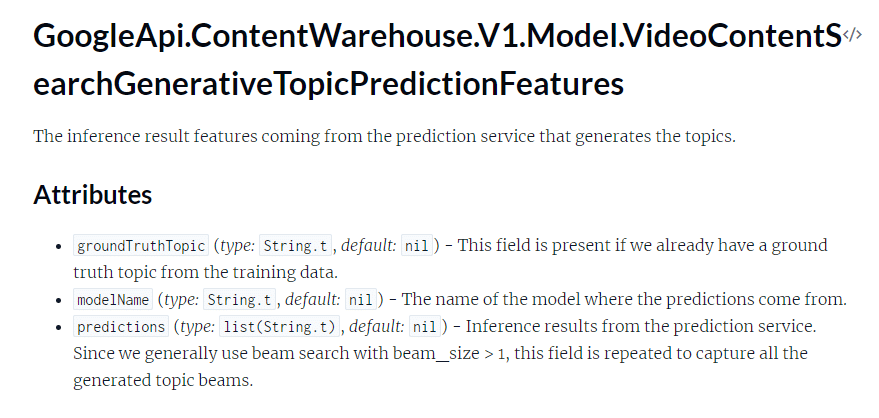
New discoveries from the leak
Some conversations I’ve had and observed over the past two days has helped me recontextualize my findings – and also dig for more things in the documentation.
Baby Panda is not HCU
Someone with knowledge of Google’s internal systems was able to answer that the Baby Panda references an older system and is not the Helpful Content Update.
I, however, stand by my hypothesis that HCU exhibits similar properties to Panda and it likely requires similar features to improve for recovery.
A worthwhile experiment would be trying to recover traffic to a site hit by HCU by systematically improving click signals and links to see if it works. If someone with a site that’s been struck wants to volunteer as tribute, I have a hypothesis that I’d like to test on how you can recover.
The leaks technically go back two years
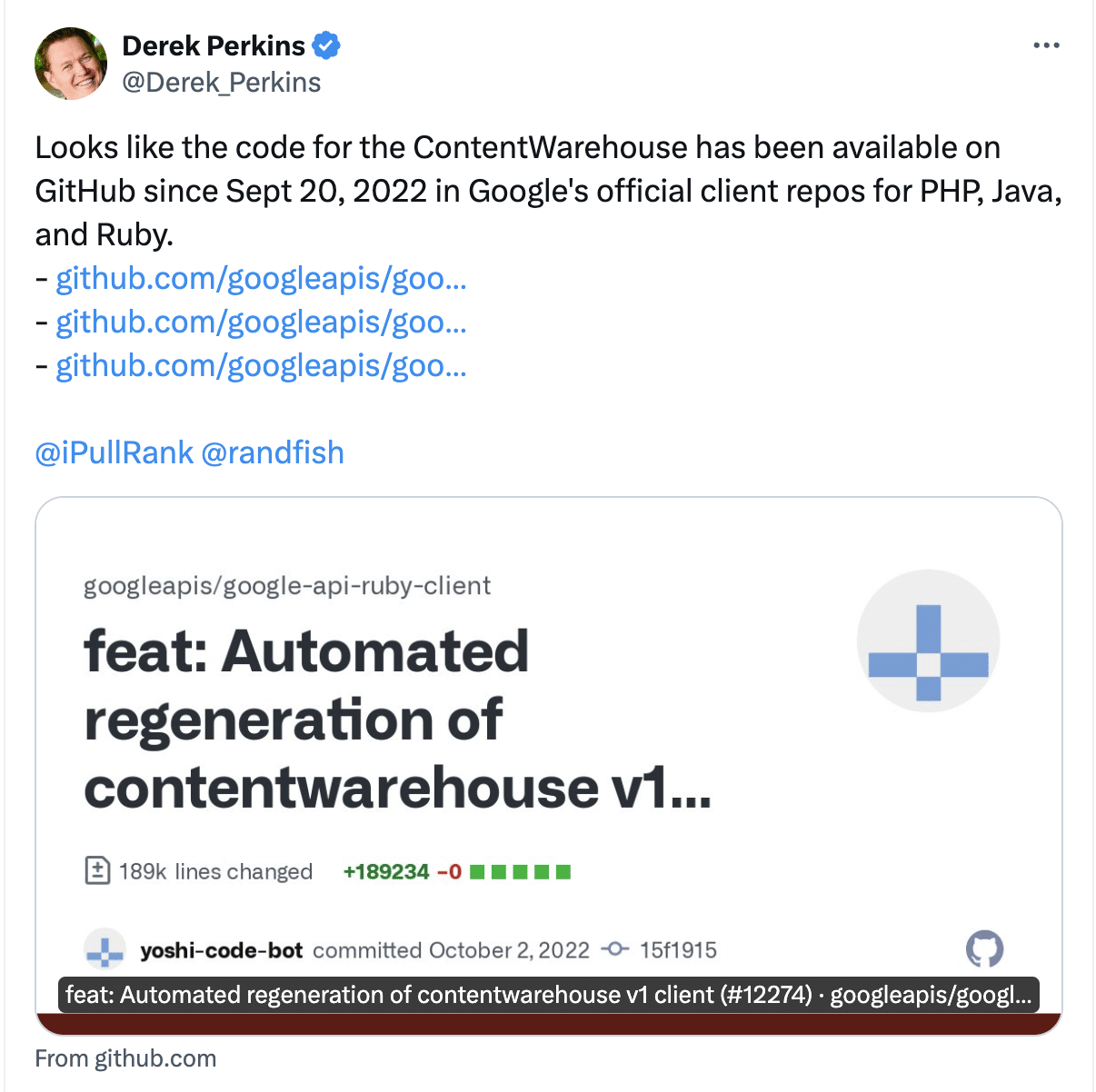
Derek Perkins and @SemanticEntity brought to my attention on Twitter that the leaks have been available across languages in Google’s client libraries for Java, Ruby, and PHP.
The difference with those is that there is very limited documentation in the code.
There is a content effort score maybe for generative AI content
Google is attempting to determine the amount of effort employed when creating content. Based on the definition, we don’t know if all content is scored by this way by an LLM or if it is just content that they suspect is built using generative AI.

Nevertheless, this is a measure you can improve through content engineering.
The significance of page updates is measured
The significance of a page update impacts how often a page is crawled and potentially indexed. Previously, you could simply change the dates on your page and it signaled freshness to Google, but this feature suggests that Google expects more significant updates to the page.

Pages are protected based on earlier links in Penguin
According to the description of this feature, Penguin had pages that were considered protected based on the history of their link profile.

This, combined with the link velocity signals, could explain why Google is adamant that negative SEO attacks with links are ineffective.
Toxic backlinks are indeed a thing
We’ve heard that “toxic backlinks” are a concept that simply used to sell SEO software. Yet there is a badbacklinksPenalized feature associated with documents.
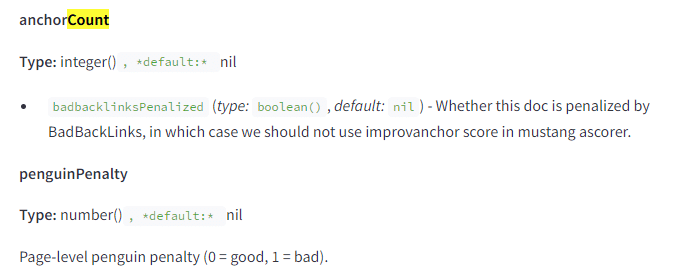
There’s a blog copycat score
In the blog BlogPerDocData module there is a copycat score without a definition, but is tied to the docQualityScore.
My assumption is that it is a measure of duplication specifically for blog posts.

Mentions matter a lot
Although I have not come across anything to suggest mentions are treated as links, there are lot of mentions of mentions as they relate to entities.
This simply reinforces that leaning into entity-driven strategies with your content is a worthwhile addition to your strategy.
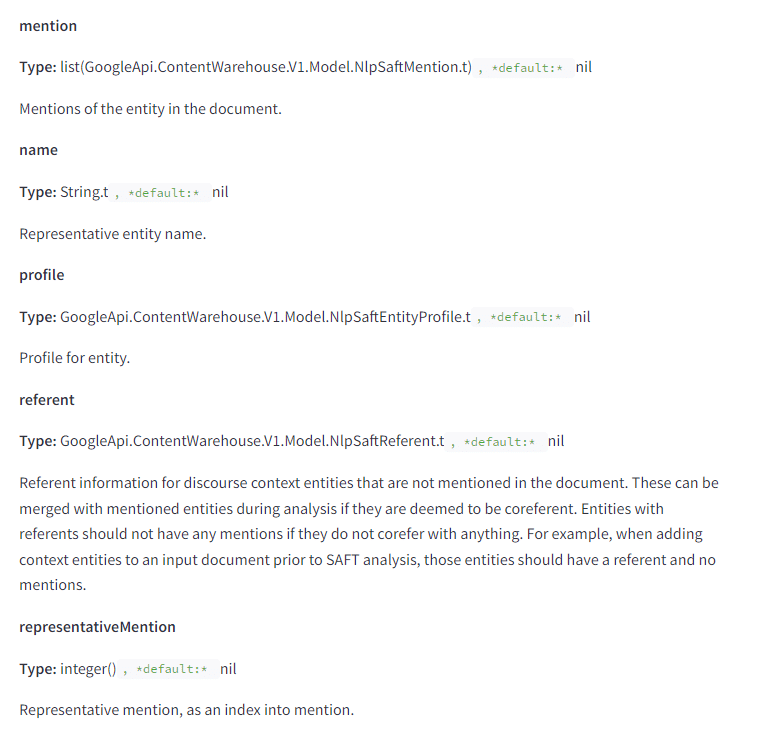
Googlebot is more capable than we thought
Googlebot’s fetching mechanism is capable of more than just GET requests.
The documentation indicates that it can do POST, PUT, or PATCH requests as well.
The team previously talked about POST requests, but it the other two HTTP verbs have not been previously revealed. If you see some anomalous requests in your logs, this may be why.

Specific measures of ‘effort’ for UGC
We’ve long believed that leveraging UGC is a scalable way to get more content onto pages and improve their relevance and freshness.
This ugcDiscussionEffortScore suggests that Google is measuring the quality of that content separately from the core content.
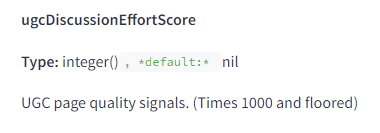
When we work with UGC-driven marketplaces and discussion sites, we do a lot of content strategy work related to prompting users to say certain things. That, combined with heavy moderation of the content, should be fundamental to improving the visibility and performance of those sites.
Google detects how commercial a page is
We know that intent is a heavy component of Search, but we only have measures of this on the keyword side of the equation.
Google scores documents this way as well and this can be used to stop a page from being considered for a query with informational intent.

We’ve worked with clients who actively experimented with consolidating informational and transactional page content, with the goal of improving visibility for both types of terms. This worked to varying degrees, but it’s interesting to see the score effectively considered a binary based on this description.
Cool things I’ve seen people do with the leaked docs
I’m pretty excited to see how the documentation is reverberating across the space.
Natzir’s Google’s Ranking Features Modules Relations: Natzir builds a network graph visualization tool in Streamlit that shows the relationships between modules.
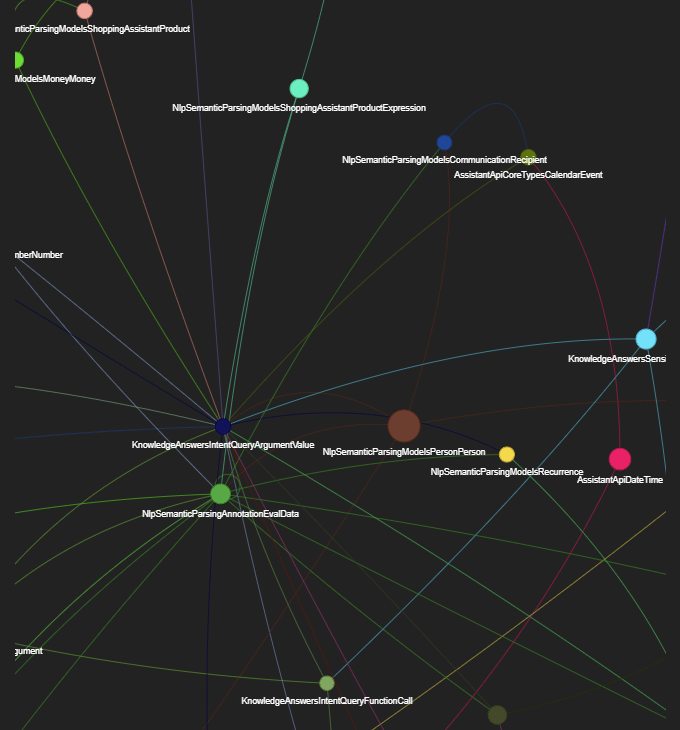
WordLifti’s Google Leak Reporting Tool: Andrea Volpini built a Streamlit app that lets you ask custom questions about the documents to get a report.
Direction on how to move forward in SEO
The power is in the crowd and the SEO community is a global team.
I don’t expect us to all agree on everything I’ve reviewed and discovered, but we are at our best when we build on our collective expertise.
Here are some things that I think are worth doing.
How to read the documents
If you haven’t had the chance to dig into the documentation on HexDocs or you’ve tried and don’t know here to start, worry not, I’ve got you covered.
- Start from the root: This features listings of all the modules with some descriptions. In some cases attributes from the module are being displayed.
- Make sure you’re looking at the right version: v0.5.0 Is the patched version The versions prior to that have docs we’ve been discussing.
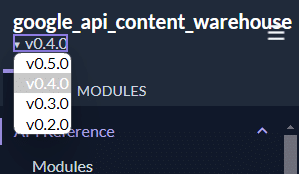
- Scroll down until you find a module that sounds interesting to you: Look through the names and click things that sound interesting. I focused on elements related to search, but you be interested in Assistant, YouTube, etc.
- Read through the attributes: As you read through the descriptions of features take note of other features the are referenced in them.
- Search: Use that perform searches for those terms in the docs
- Repeat until you’re done: Go back to step 1. As you learn more you’ll find other things you want to search and you’ll realize certain strings might mean there are other modules that interest you.
- Share your findings: If you find something cool, share it on social or write about it. I’m happy to help you amplify.
One thing that annoys me about HexDocs is how the left sidebar covers most of the names of the modules. This makes it difficult to know what you’re navigating to.
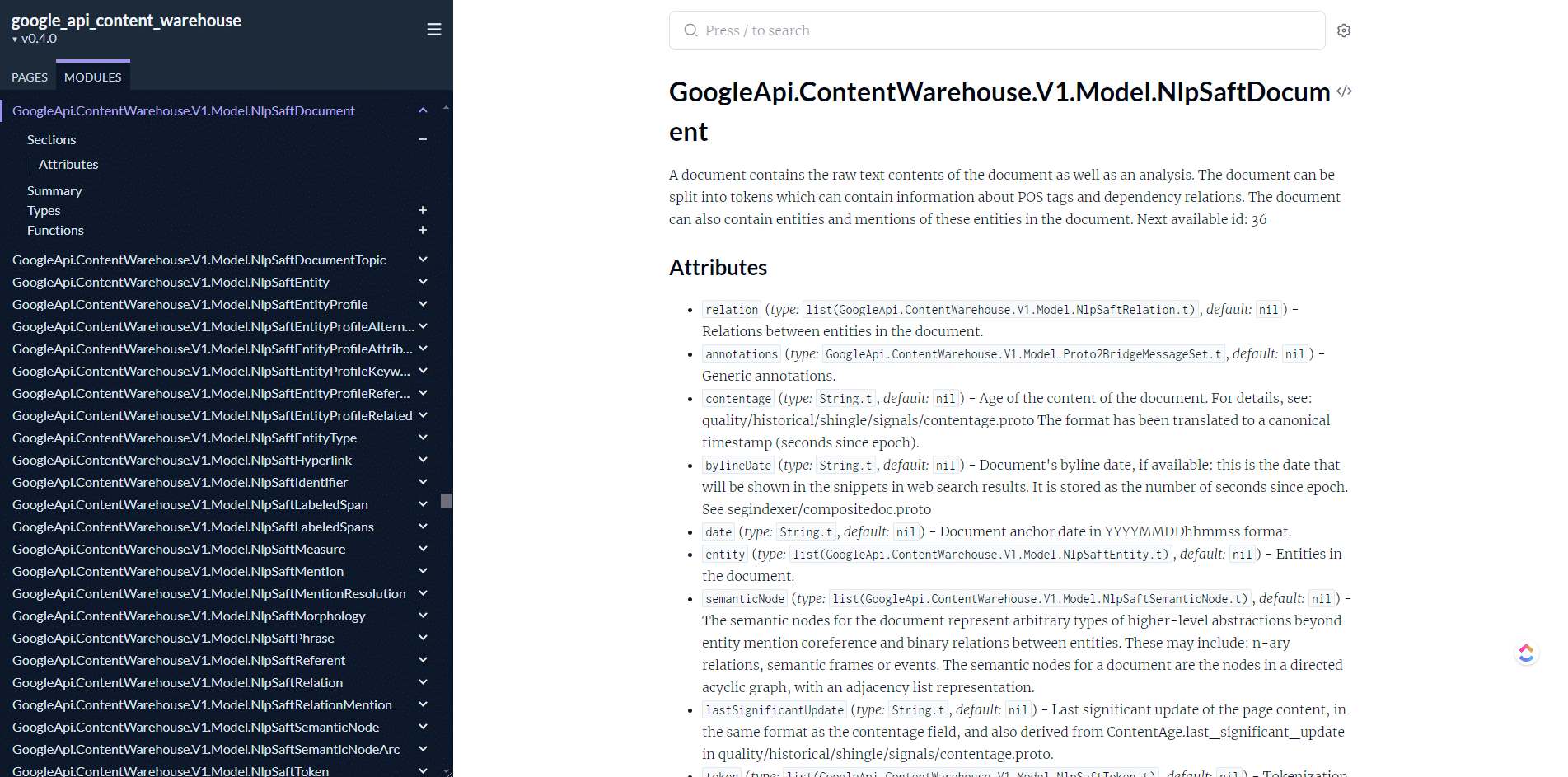
If you don’t want to mess with the CSS, I’ve made a simple Chrome extension that you can install to make the sidebar bigger.
How your approach to SEO should change strategically
Here are some strategic things that you should more seriously consider as part of your SEO efforts.
If you are already doing all these things, you were right, you do know everything, and I salute you. 
SEO and UX need to work more closely together
With NavBoost, Google is valuing clicks one of the most important features, but we need to understand what session success means. A search that yields a click on a result where the user does not perform another search can be a success even if they did not spend a lot of time on the site. That can indicate that the user found what they were looking for. Naturally, a search that yields a click and a user spends 5 minutes on a page before coming back to Google is also a success. We need to create more successful sessions.
SEO is about driving people to the page, UX is about getting them to do what you want on the page. We need to pay closer attention to how components are structured and surfaced to get people to the content that they are explicitly looking for and give them a reason to stay on the site. It’s not enough to hide what I’m looking for after a story about your grandma’s history of making apple pies with hatchets or whatever these recipe sites are doing. Rather it should be more about here’s the exact information clearly displayed and enticing the user to remain on the page with something additionally compelling.
Pay more attention to click metrics
We look at the Search Analytics data as outcomes when Google’s ranking systems look at them as diagnostic features. If you rank highly and you have a ton of impressions and no clicks (aside from when SiteLinks throws the numbers off) you likely have a problem. What we are definitively learning is that there is a threshold of expectation for performance based on position. When you fall below that threshold you can lose that position.
Content needs to be more focused
We’ve learned, definitively, that Google uses vector embeddings to determine how far off given a page is from the rest of what you talk about. This indicates that it will be challenging to go far into upper funnel content successfully without a structured expansion or without authors that have demonstrated expertise in that subject area. Encourage your authors to cultivate expertise in what they publish across the web and treat their bylines like the gold standard that it is.
SEO should always be experiment-driven
Due to the variability of the ranking systems, you cannot take best practices at face value for every space. You need to test and learn and build expertmentation into every SEO program. Large sites leveraging products like SEO split testing tool Searchpilot are already on the right track, but even small sites should be testing how they structure and position their content and metadata to encourage stronger click metrics. In other words we need to be actively testing the SERP not just testing the site.
Pay attention to what happens after they leave your site
We now have verification that Google is using data from Chrome as part of the search experience. There is value in reviewing the clickstream data that SimilarWeb and Semrush .Trends provide to see where people are going next and how you can give them that information without them leaving you.
Build keyword and content strategy around SERP format diversity
With Google potentially limiting the number of pages of a certain content types ranking in the SERP, you should be checking for this in the SERPs as part of your keyword research. Don’t align formats with keywords if there’s no reasonable possibility of you ranking.
How your approach to SEO should change tactically
Tactically, here are some things you can consider doing differently. Shout out to Rand because a couple of these ideas are his.
Page titles can be as long as you want
We now have further evidence that indicates the 60-70 character limit is a myth. In my own experience we have experimented with appending more keyword-driven elements to the title and it has yielded more clicks because Google has more to choose from when it rewrites the title.
Use fewer authors on more content
Rather than using an array of freelance authors you should work with fewer that are more focused on subject matter expertise and also write for other publications.
Focus on link relevance from sites with traffic
We’ve learned that link value is higher from pages that prioritized higher in the index. Pages that get more clicks are pages that are likely to appear in Google’s flash memory. We’ve also learned that Google is valuing relevance very highly. We need to stop going after link volume and solely focus on relevance.
Default to originality instead of long form
We now know originality is measured in multiple ways and can yield a boost in performance. Some queries simply don’t require a 5000 word blog post (I know I know). Focus on originality and layer more information in your updates as competitors begin to copy you.
Make sure all dates associated with a page are consistent
It’s common for dates in schema to be out of sync with dates on the page and dates in the XML sitemap. All of these need to be synced to ensure Google has the best understanding of how hold the content is. As you are refreshing your decaying content make sure every date is aligned so Google gets a consistent signal.
Use old domains with extreme care
If you’re looking to use an old domain, it’s not enough to buy it and slap your new content on its old URLs. You need to take a structured approach to updating the content to phase out what Google has in its long term memory. You may even want to avoid their being a transfer of ownership in registrars until you’ve systematically established the new content.
Make gold standard documents
We now have evidence that quality raters are doing feature engineering for Google engineers to train their classifiers. You want to create content that quality raters would score as high quality so your content has a small influence over what happens in the next core update.
Bottom line
It’s short-sighted to say nothing should change. Really, I think it’s time for us to truly reconsider our best practices based on this information.
Let’s keep what works and dump what’s not valuable. Because, I tell you what, there’s no text to code ratio in these documents, but several of your SEO tools will tell your site is falling apart because of it.
How Google can repair its relationship with the SEO community
A lot of people have asked me how can we repair our relationship with Google moving forward.
I would prefer that we get back to a more productive space for the betterment of the web. After all we are aligned in our goals of making search better.
I don’t know that I have a complete solution, but I think an apology and owning their role in misdirection would be a good start. I have a few other ideas that we should consider.
- Develop a working relationships with us: On the advertising side, Google wines and dines its clients. I understand that they don’t want to show any sort of favoritism on the organic side, but Google needs to be better about developing actual relationships with the SEO community. Perhaps a structured program with OKRs that is similar to how other platforms treat their influencers makes sense. Right now things are pretty ad hoc where certain people get invited to events like I/O or to secret meeting rooms during the (now-defunct) Google Dance.
- Bring back the annual Google Dance: Hire Lily Ray to dj and make it about celebrating annual OKRs that we have achieved through our partnership.
- Work together on more content: The bidirectional relationships that people like Martin Splitt have cultivated through his various video series are strong contributions where Google and the SEO community have come together to make things better. We need more of that.
- We want to hear from the engineers more. Personally, I’ve gotten the most value out of hearing directly from search engineers. Paul Haahr’s presentation at SMX West 2016 lives rent-free in my head and I still refer back to videos from the 2019 Search Central Live Conference in Mountain View regularly. I think we’d all benefit from hearing directly from the source.
Everybody keep up the good work
I’ve seen some fantastic things come out of the SEO community in the past 48 hours.
I’m energized by the fervor with which everyone has consumed this material and offered their takes – even when I don’t agree with them. This type of discourse is healthy and what makes our industry special.
I encourage everyone to keep going. We’ve been training our whole careers for this moment.
from Search Engine Land https://ift.tt/ekJWVGS
via https://ift.tt/x49MTl0 https://ift.tt/ekJWVGS
Wednesday, May 29, 2024
Delhi Woman Disguised As Courier Agent Attempts Robbery. Arrested
Google responds to leak: Documentation lacks context
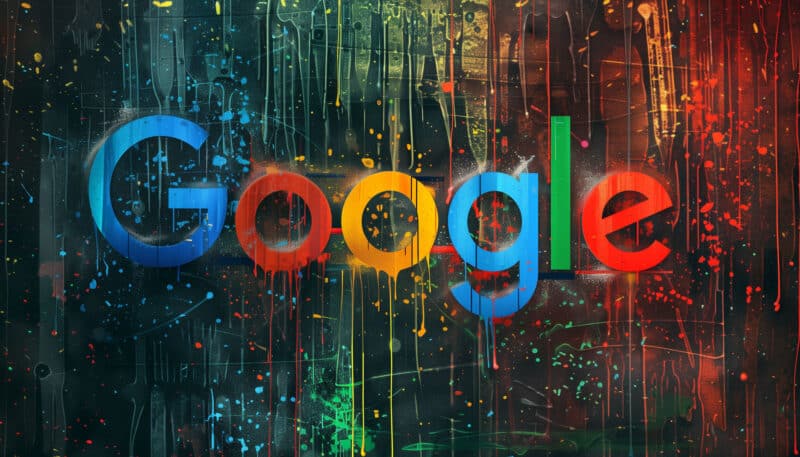
The search community is still unpacking and processing the huge reveal of the Google Search ranking documents that were made public yesterday morning. Everyone has been asking, why has Google not commented on the leak. Well, Google has finally commented – we spoke to a Google spokesperson about the data leak.
Google told us. Google told us that there are a lot of assumptions being published based on the data leak that are being taken out of context, that are incomplete and added that search ranking signals are constantly changing. This is not to say Google’s core rankings principles change, they do not, but the specific and individual signals that go into Google rankings do change, Google told us.
A Google spokesperson sent us the following statement:
“We would caution against making inaccurate assumptions about Search based on out-of-context, outdated, or incomplete information. We’ve shared extensive information about how Search works and the types of factors that our systems weigh, while also working to protect the integrity of our results from manipulation.”
Google, however, won’t comment about the specific elements, which are accurate, which are invalid, which are currently being used, how are they being used, and how strongly (weighted) they are being used. Google won’t comment about specifics because Google never comments on specifics when it comes to its ranking algorithm, a Google spokesperson told me. Google said if they did comment, spammers and/or bad actors can use it to manipulate its rankings.
Google also told us that it would be incorrect to assume that this data leak is comprehensive, fully-relevant or even provides up-to-date information on its Search rankings.
Did Google lie to us. That is hard to say for sure. There are some clear details about ranking signals Google historically told us they do not use, that were specifically mentioned in the leaked documents. Of course, Google’s statement says what is in the document may have never been used, been tested for a period of time, may have changed over the years or may be used. Again, Google won’t get into specifics.
Of course, a lot of folks in the SEO community have always felt Google has lied to us and that you should do your own testing to see what works in SEO and what does not work in SEO.
I, for one, trust people when they look me in the eye and tell me something. I do not believe the Google representatives I’ve spoke to over the years lied outright to me. Maybe it was about semantics of language, maybe Google wasn’t using a specific signal at that time or maybe I am super naive (which is very possible) and Google has lied.
Google communication. Google told me they are still committed to providing accurate information, but as I noted above, they will not do so in specific detail on a ranking signal-by-signal basis. Google also said that its ranking systems do change over time and it will continue to communicate information that it can to the community.
Does it matter. Either way, ultimately, these signals all point to the same thing. I believe Mike King, who was the first to dig into this document and help reveal the details, said that ultimately we need to build content and a website that people want to visit, want to spend time on, want to click over to and want to link to. The best way to do that is to build a website and content that people want like and enjoy. So the job of an SEO is to continue to build great sites, with great content. Yea, it is a boring answer – sorry.
What happened. As we covered, thousands of documents, which appear to come from Google’s internal Content API Warehouse, were released March 13 on Github by an automated bot called yoshi-code-bot. These documents were shared with Rand Fishkin, SparkToro co-founder, earlier this month.
Why we care. As we reported earlier, we have been given a glimpse into how Google’s ranking algorithm may work, which is invaluable for SEOs who can understand what it all means. As a reminder, in 2023, we got an unprecedented look at Yandex Search ranking factors via a leak, which was one of the biggest stories of that year. This Google leak is likely going to be the story of the year – maybe of the century.
But what do we do with this information? Probably exactly what we have been doing without this information – build awesome sites with awesome content.
The articles. Here are the two main articles that broke this story on this Google data leak:
- Secrets from the Algorithm: Google Search’s Internal Engineering Documentation Has Leaked by King on iPullRank
- An Anonymous Source Shared Thousands of Leaked Google Search API Documents with Me; Everyone in SEO Should See Them by Fishkin on SparkToro
from Search Engine Land https://ift.tt/lXDQ4pN
via https://ift.tt/C2xcHyQ https://ift.tt/lXDQ4pN
Delhi Hits 52.3 Degrees, Highest-Ever Recorded Temperature In India
200 Teams, Water Wastage Fine: Delhi Acts Tough To Tackle Capital Crisis
Tuesday, May 28, 2024
Rajkot Fire: Gujarat Cracks Down On Non-Compliant Gaming Zones
Google Business Profile chat and call history going away

Google will be shutting down the Google Business Profile chat and call history feature on July 31, 2024. Google will stop allowing new chats to be initiated starting on July 15, 2024 and then will totally disable the chat and call history features on July 31, 2024.
What Google said. Google sent out numerous types of emails to businesses, depending on if they uses the chat or call history feature. The email says:
“We are reaching out to share that we will be winding down Google’s chat and call history features in Google Business Profile on July 31, 2024. We acknowledge this may be difficult news – as we continually improve our tools, we occasionally have to make difficult decisions which may impact the businesses and partners we work with. It’s important to us that Google remains a helpful partner as you manage your business and we remain committed to this mission.”
Important dates. Here are the upcoming dates you need to be aware of:
- July 15, 2024: Searchers will no longer be able to start new chat conversations with your business from Google Maps or Google Search. However, searchers that are already in existing chat conversations will be notified that chat will be phased out.
- July 31, 2024: The chat functionality in Google Business Profile will end completely and you will no longer receive new chat messages. You will also no longer be able to see your Google Business Profile call history in Google Business Profile.
History download. You can download your chat and call history from Google Business Profiles, so you can store them somewhere. At some point, Google will delete the history.
The email. Here is a screenshot of the email I received:

Why we care. If you used these features for your business, please be aware they are going away soon. You may want to download your chat and call history before the deadline, so that you can archive that data in your CRM software and database.
from Search Engine Land https://ift.tt/bdBgPa1
via https://ift.tt/DAyOI8a https://ift.tt/bdBgPa1
Monday, May 27, 2024
3 Injured After Rusted Mortar Shell Explodes In J&K's Samba: Cops
Lawyer, Son Kill Retired Air Force Personnel In Nagpur, Arrested: Cops
"Swati Maliwal's Action Not Pre-Meditated": Court Denies Bail To Accused
Sunday, May 26, 2024
Cleaner Killed In Dumper Truck Accident In Navi Mumbai
53.64 Lakh Foreign-Brand Cigarette Sticks Worth Rs 8 Crore Seized In Mumbai
At 48.3 Degrees, Delhi's Mungeshpur Records Highest Temperature
Saturday, May 25, 2024
3 Dead As Fire Breaks Out In Residential Building In Delhi
6 Babies Dead, Several Injured In Massive Fire At Delhi Children's Hospital
This Haryana Village Didn't Vote Over Demand For Bridge Construction
Fire Breaks Out At Children's Hospital In Delhi, 11 Newborns Rescued
Friday, May 24, 2024
Maneka Gandhi To Mehbooba Mufti, Key Leaders Taking Poll Test Today
The latest jobs in search marketing

Looking to take the next step in your search marketing career?
Below, you’ll find the newest jobs at brands and agencies in SEO, PPC and digital marketing – as well as positions we’ve shared in previous weeks that are still open.
Newest jobs in SEO, PPC and digital marketing
Senior SEO Manager, Interactive Strategies (Hybrid, Washington, DC)
- Salary: $85,000 – $105,000
- Developing and executing effective SEO strategies
- Conducting keyword research and analysis
Senior SEO Manager, GoPro (Remote)
- Salary: $114,800 – $152,500
- Develop and implement forward-looking SEO strategies that drive organic traffic lift and take advantage of rising search trends
- Monitor and drive SEO technical optimizations, partnering with web engineering and merchandising
Search Engine Optimization Manager, BlueFile (Remote)
- Salary: $120,000 – $165,000
- Develop and execute comprehensive SEO strategies aligned with business goals.
- Develop and maintain KPIs including CTR, search rankings, conversion rates, and domain authority. growth, search traffic growth, technical SEO issue resolution, and website performance.
SEO Specialist, Disruptive Advertising (Remote)
- Salary: $75,000 – $85,000
- Perform comprehensive client SEO audits
- Identify KPIs to measure organic success with clients
Digital Optimization Specialist, American House (Remote)
- Salary: $80,000
- Develops SEO strategy by studying trends and updates within local, national, and technical SEO disciplines.
- Tests and optimizes elements of the website to increase the flow of qualified leads into the CRM and marketing automation systems.
PPC Manager, Mody Capital (Austin, TX)
- Salary: $70,000 – $100,000
- Design and implement effective digital advertising strategies that align with our business goals.
- Monitor and optimize campaign budgets and performance to ensure maximum ROI.
Growth Manager for Paid Social, Spin Hire, (New York, NY)
- Salary: $95,000 – $110,000
- Develop and execute advanced digital marketing strategies through Ads Manager, including Facebook, Instagram, Pinterest, Snapchat, TikTok, etc.
- Manage and optimize paid social campaigns for medium to large clients, ensuring high performance and client satisfaction.
Sr. Manager Paid Search – Men’s Grooming Brand, Method Recruiting, (New York, NY)
- Salary: $130,000
- Create and manage campaigns across SEM tactics and assist in management of YouTube campaigns.
- Oversee PPC day-to-day optimization and budget management across multiple campaigns and platforms, to achieve new customer business targets and meet efficiency goals
Digital Marketing Manager (Paid Media / SEO), Creative Circle, (New York, NY)
- Salary: $90,000 – $110,000
- Manage paid media + SEO channels to reach small business owners across the US
- Develop / execute digital ad campaigns across Google Ads, Meta Ads, LinkedIn Ads, etc.
Paid Digital Media AdOperations, The Well Advertising, (Remote)
- Salary: $60,000 – $80,000
- Manage paid digital advertising & all auction-based placements (including YouTube, Google, Microsoft, and Meta)
- Setup and ongoing optimization and management of PPC/Digital Advertising campaigns for multiple clients
More SEO jobs
Search Engine Optimization Manager, SearchLab (Remote)
- Salary: $85,000 – $95,000
- Identify and audit the SEO campaigns of potentially high-risk clients and help the team craft solutions to solve poor performance.
- Conduct weekly meetings with SEO Team Leads to ensure alignment and resolve obstacles to the team’s work.
Search Engine Optimization Manager, Jordan Digital Marketing (Remote)
- Salary: $75,000 – $95,000
- Work across several accounts to drive the maximum results from Organic Search, using advanced SEO and content strategies both on and off-page
- Develop and execute a collaborative SEO strategy for clients that’s aligned with their business goals and best practices
Manager, SEO, Dentsu (Remote)
- Salary: $51,000 – $80,000
- Responsible for the development, prioritization, and execution of SEO strategies based on scope and client needs.
- Work closely with and mentor junior staff on completing SEO deliverables and overall SEO expertise.
Head of SEO, Meriwether (Remote)
- Salary: $75,000 (annual)
- Learn the Meriwether way of SEO through 1:1 coaching with our founder, Josh. Become lead strategist and main POC for 4-8 clients.
- Learn the ins and outs of our content ops and “Lean” — our agency operating system.
Senior Manager, Growth Marketing, Talkiatry (Remote)
- Salary: $140,000 – $150,000 (annual)
- Develop and execute testing roadmap to increase conversion rates across all marketing surfaces (website, landing pages, SEO initiatives)
- Develop organic channel and SEO product opportunities and strategies
Search Engine Optimization Manager, Jordan Digital Marketing (Remote)
- Salary: $705000 to $95,000 (annual)
- Work across several accounts to drive the maximum results from Organic Search, using advanced SEO and content strategies both on and off page.
- Diagnose and prioritize organic opportunities for growth through data platforms, technical and UX audits, content performance and more.
SEO Consultant, Botify (Remote)
- Salary: $130,000 (annual)
- Engage in discovery sessions to learn about customers’ businesses, their strategic initiatives, goals, and progress towards achieving the goals
- Carry out detailed site audits and propose and present SEO strategies and roadmaps
Principal SEO, GoodRX (Remote)
- Salary: $135,000 to $288,000 (annual)
- Influence the SEO strategy for the business at large and generate buy-in from executive leadership.
- Highlight trends and competitor movement within the rapidly evolving health vertical.
Associate Director, SEO, Brainlabs (New York, NY)
- Salary: $100,000 to $120,000 (annual)
- Owns, manages, and grows client relationships through exceptional communication, account management, and SEO expertise
- Accountable for all action items, as agreed upon with the client
SEO Specialist, Nintendo (Redmond, WA)
- Salary: $76,641 to $114,961 (annual)
- Driving digital transformation in the areas of UX and operations through technology, data, process and leadership.
- Lead the creative, content strategy and technology efforts of our digital experiences.
Senior SEO Content Strategist, North Star Inbound (Remote)
- Salary: $65,000 to $75,000 (annual)
- Conduct keyword research to inform client strategy.
- Ideate creative content ideas based on research of industry trends, keywords, competitor analysis, and trending topics.
SEO Specialist, Pure Visibility (Remote)
- Salary: $58,000 to $65,000 (annual)
- Work with the SEO director to perform in-depth visibility audits for new clients and compile the results along with prioritized recommendations.
- Work with the SEO director to analyze and create action plans around common technical SEO components (canonicalization, sitemaps, crawl budget, schema, hreflang).
SEO Strategist, Online Optimism (Remote)
- Salary: $51,000 (annual)
- Oversee the search and content management of 6 – 10 of Online Optimism’s search & content accounts.
- Perform keyword research for clients, to determine valuable pieces of content to rank for.
More PPC jobs
Senior Performance Marketing Manager, Recruitics (Hybrid, New York, NY)
- Salary: $76,500 – $100,000
- Work in platform to configure campaigns – setup budgets, targeting, creative and run dates
- Partner with ad ops to install and configure pixels to track events and create remarketing audiences. Partner with the Client Integrations team to guide proper event configuration.
Director, Paid Search, Amp (Remote)
- Salary: $120,000 – $150,000
- Create meaningful strategic approach by applying insights around client’s business/brand, the consumer journey and the marketplace
- Ensure that plan execution stays on strategy and that cadenced optimization/maintenance occurs
Senior Manager, Paid Search (B2B), NP Digital (Remote)
- Salary: $100,000 – $115,000
- Deliver B2B paid search media strategy and recommendations for clients
- Project estimated campaign performance results based on client budgets and benchmark costs and rates
Director of Paid Search, Resident (Remote)
- Salary: $108,000 – $157,500 (annual)
- Execute day-to-day campaign building, optimization, and maintenance for multiple Google Ads accounts – ideation, keyword opportunities, campaign structuring, targeting, testing, reporting, etc.
- Manage and implement campaigns across Paid Search, Shopping, Discovery Ads and Gmail Ads as well as all Bing products.
Director, Paid Search, Digital Matter (New York, NY)
- Salary: $136,000 to $165,000 (annual)
- Manage execution and performance of search, shopping, display, and video advertising campaigns through the full account management life cycle
- Serve as the key player in kick-off meetings, client relationship management, ad-serving, tech stack implementation, campaign optimization, and quarterly business planning.
Senior Manager, Paid Social, Tinuiti (Remote)
- Salary: $125,000 (annual)
- Demonstrate deep understanding of your book of business as it related to paid social strategy, leading innovative media plans and roadmap development.
- Foster strong client relationships through excellent communication and providing valuable insights.
Lead Paid Media Strategist, JustWatch (Los Angeles, CA)
- Salary: $85,000 to $95,000 (annual)
- Independently set up and steer campaigns for our clients using our custom-built internal tools.
- Assist and ensure successful campaign rollout, monitor campaign performance on various social platforms, and ensure high quality and accuracy.
Other SEM and digital marketing jobs
Facebook Ads Specialist (Media Buyer), Golden Hippo (Remote)
- Salary: $75,700 to $101,000 (annual)
- Set-up, manage, analyze and scale Facebook campaigns and budgets on a daily, weekly, and monthly basis to keep spend optimized for sales growth while hitting strict ROI goals.
- Drive creation of new ad creatives both through own ideas as well as collaboration with copy and video creative departments to ensure that we have new, exciting creative to test for every offer each week.
Digital Marketing Manager, Revelwood (New Jersey, NJ)
- Salary: $90,000 to $100,000 (annual)
- Research, develop and execute an annual strategic digital marketing plan.
- Increase MQLs with a high conversion rate.
Account Strategist, Digital Advertising Sales, Google (Los Angeles, CA)
- Salary: $79,000 to $114,000 (annual)
- Build and manage relationships with clients, and develop an understanding of their business challenges, marketing objectives, and success metrics.
- Work proactively and cooperatively with internal and external stakeholders to ensure workflows and projects are completed on time to a high standard.
Are you looking to hire?
You can submit your job listing details here for free. Please include:
- Job title.
- Company.
- Job listing URL.
- Date when the job listing closes.
- Where the position is located (e.g., remote, city, country).
- Salary range (we will not include job listings in this article unless they include this).
Note: We update this post weekly. So make sure to bookmark this page and check back.
from Search Engine Land https://ift.tt/BA5J3px
via https://ift.tt/F3lJLAZ https://ift.tt/BA5J3px
Video: Noida Man's Bizarre 'Stunts' In SUV Involve Scaring College Students
2 Suffocate To Death While Cleaning Septic Tank In Delhi: Police
Thursday, May 23, 2024
Mumbai Man Dials 1930, Cops Save Rs 40 lakh Extorted By Cyber Fraudster
TikTok debuts AI-powered ad automation tools

TikTok unveiled a suite of new AI and automation tools for advertisers at its TikTok World event, aiming to make it easier for brands to create effective ads at scale on the viral video platform.
The big picture. TikTok is leaning into AI and automated ad tech as it looks to cement itself as more than just a media platform, but as a key “business partner” driving sales and ROI for brands.
New tools rundown. Four tools to take note of:
- TikTok One – A centralized hub giving advertisers access to creators, creative tools, partners and measurement capabilities.

- TikTok Symphony – An umbrella for TikTok’s AI ad tools, including support for:
- Script writing
- Video production
- Creative asset optimization
- Automated ad optimization. Using AI to optimize ad creative, targeting, budgets and more to hit set campaign goals like purchases or awareness.
- TikTok shop automation. AI tools to optimize ad spend, bidding, creative and other e-commerce costs for TikTok Shop ads.

Why we care. TikTok is a powerful platform for driving sales and ROI. These new AI and automation tools can significantly enhance ad creation and effectiveness.
What they’re saying. Adrienne Lahens, TikTok’s global head of creator marketing solutions, said:
- “We’re building for the future of creative, and we’re inviting brands to come and test and learn with us.”
Early results. An Ohio wellness brand piloting TikTok’s Shop automation tools saw 136% higher sales and 4x higher ROI while saving 10 hours per week, TikTok claims.
U.S. ban. TikTok declined to comment on whether advertising has been impacted by the threat of a potential U.S. ban over data security concerns.
The bottom line. TikTok is making an aggressive push into AI-driven ad automation as it tries to position itself as an essential sales and marketing channel rivaling Google and ad tech players.
from Search Engine Land https://ift.tt/sZNSaDy
via https://ift.tt/q2jymTp https://ift.tt/sZNSaDy
Woman's Unique Protest To Flag Poor Condition Of Roads In Hyderabad
Wednesday, May 22, 2024
Girl, 11, Raped By Auto Driver In Madhya Pradesh, Accused Arrested: Cops
Tuesday, May 21, 2024
E-Rickshaw Driver Stabbed Multiple Times In Chest, Neck In Delhi, Dies
Google Marketing Live 2024: Everything you need to know
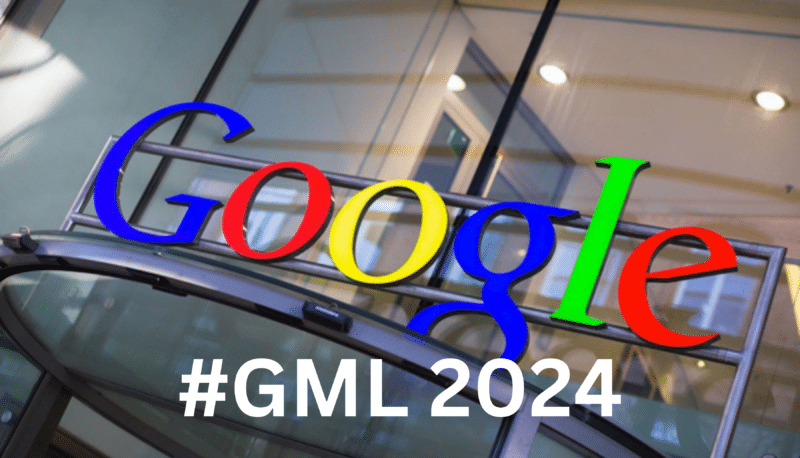
Unsurprisingly, AI took center stage during the various announcements made today at Google Marketing Live 2024.
Updates also focused on creatives, data and giving the consumer what they want straight from the Search results. Now is the time to start paying closer attention to your impression levels.

Here’s a recap of everything you need to know from Google Marketing Live, with links to our full coverage of each major announcement.
Google PMax upgrade allows mass AI creative asset production
You can now produce high-quality creative assets rapidly and at scale for Performance max campaigns.
With Generative AI, will be able to create ads a lot faster, have brand customized ads, advanced image editing and automatic showcasing of product feeds in AI-generated creatives
New reporting functionalities have also been rolled out for Youtube and creative assets.
Google rolls out immersive, AI-powered Shopping Ads
Video and virtual ad types come for Shopping Ads advertisers.
Retailers can integrate short-form product videos into ads, virtual try on allows shoppers to see how tops fit different body types, and 3D show spins.
Allowing consumers to engage with your creative and products (virtually) before landing on your page.
Google visual storytelling advances for YouTube, Discover, Gmail
You can now target your potential customers with vertical videos, stickers, and automatically generated animated image ads.
These video ads are now available across the 3 billion users across YouTube, Discover and Gmail through Demand Gen campaigns.
More variety for your Demand Gen campaigns.
Google starts testing ads in AI overviews
Your relevant Search and Shopping ads will appear in “sponsored” sections within AI-generated overview boxes on the SERP.
No need for you to do anything – existing Search, PMax and Shopping campaigns will be eligible.
How to make it not eligible – that is unknown as of now.
Google’s first-party data unification Ads Data Manager available to all
Centralize and activate your first-party data for more effective AI-powered campaigns with Google’s Data Manager Tool now available to everyone.
Use it for data integration (consolidates disparate first-party data sources into a unified analytics hub) and audience insights and targeting.
Google gives merchants new brand profiles, AI branding tools
New tools have been released to better showcase your brands and create visual content.
You can create a brand profile to highlight key merchant information on Search, featuring brand imagery, videos, customer reviews, deals, and more.
Product Studio now includes brand alignment features that let you use uploaded images to inspire your AI-generated ad and the ability to create videos from a single product photo.
Google tests AI-powered ads for complex purchases
Google is testing giving consumers an interactive experience upon getting their search results.
AI will be used to provide tailored advice and recommendations based on user needs and context.
The aim is to improve user experience on the SERP and provide a ready to convert consumer when they reach the brand landing page.
But what will this do to search traffic to brand sites? Time will tell.
Why we care. A lot of updates this year focused on less effort for a consumer to click through the site. So it will be interesting to see what that leads to for driving traffic. Still, there are several functionalities that have been introduced that have been long awaited (like reporting) and allow brands to better showcase their creativity.
from Search Engine Land https://ift.tt/P2BAwnJ
via https://ift.tt/2SPYDGn https://ift.tt/P2BAwnJ
